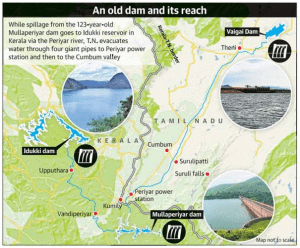DAILY CURRENT AFFAIRS (OCTOBER 27, 2022)
INDIAN POLITY
1. MULLAPERIYAR: TECHNICAL PANEL FOR PREPARING EMERGENCY ACTION PLAN
THE CONTEXT: Recently, Kerala government has constituted a technical committee for preparing an Emergency Action Plan (EAP) for the downstream part of the Mullaperiyar dam in Idukki district.
THE EXPLANATION:
- Earlier Water Resources department issued orders creating the technical committee for preparing the EAP ”downstream of the Mullaperiyar dam (Kerala part) in line with the provisions of the Dam Safety Act, 2021 and guidelines issued by the Central Water Commission for developing EAP for dams.”
Mullaperiyar dam: The current dispute
The Supreme Court order came after a court-appointed supervisory committee had suggested 139.50 ft as the permissible level. The court has directed both states to go by the committee’s recommendation. Tamil Nadu had wanted the level increased to 142 ft as fixed by the Supreme Court in 2014, while Kerala wanted it within 139 ft as per a rule curve fixed until the end of the month.
ABOUT MULLAPERIYAR DAM
- It is a masonry gravity dam on the Periyar River in the Indian state of Kerala.
- It was constructed between 1887 and 1895 and also reached an agreement to divert water eastwards to the Madras Presidency area.
- The dam created the Periyar Thekkady reservoir, from which water was diverted eastwards via a tunnel to augment the small flow of the Vaigai River.
- It originates from the Sivagiri hills of Western Ghats and flows through the Periyar National Park.
- The main tributaries of Periyar are Muthirapuzha, Mullayar, Cheruthoni, Perinjankutti.
- According to a 999-year lease agreement made during British rule, the operational rights were handed over to Tamil Nadu.

Image Courtesy: The Hindu
Kerala’s stance:
The state governments of Kerala have pointed out the unfairness of the 1886 lease agreement and its validity itself. Its core issue is the safety of the Mullaperiyar Dam. Kerala wants to decommission the 100+ year old dam and construct a new one in its place, as not doing so will endanger many lives in the process.
- The Kerala Government stated that it did not object to giving water to Tamil Nadu but pointed out that raising its level would add more pressure than the dam could take. The dams, as pointed out by Kerala, were leaking and had many structural faults.
- In addition, the Kerala government has accused Tamil Nadu of adopting an “obsolete” gate operation schedule dating back to 1939.
Tamil Nadu’s Stance:
- For Tamil Nadu, the Mullaperiyar dam and the diverted Periyar waters act as a lifeline for Theni, Madurai, Sivaganga, Dindigul and Ramnad districts, providing water for irrigation and drinking, and also for the generation of power in Lower Periyar Power Station.
- Tamil Nadu argues that building a new dam is for gaining unfair tax revenues from developing states.
- Tamil Nadu is not able to access data that is in Kerala’s terrain. There is no road built, the power supply has not been restored, although Tamil Nadu has paid for it.
HEALTH ISSUES
2. WHO RELEASES FIRST-EVER LIST OF HEALTH-THREATENING FUNGI
THE CONTEXT: Recently, WHO published a report highlighting the first-ever list of fungal “priority pathogens” – a catalogue of the 19 fungi that represent the greatest threat to public health.
THE EXPLANATION:
- The WHO fungal priority pathogens list (FPPL) is the first global effort to systematically prioritize fungal pathogens, considering the unmet research and development (R&D) needs and the perceived public health importance. The WHO FPPL aims to focus and drive further research and policy interventions to strengthen the global response to fungal infections and antifungal resistance.
- It has been divided into three categories — critical, high and medium priority.
- This classification is based on the pathogen’s public health impact or emerging antifungal resistance risk. The WHO urges a geography-wise close reading of these lists is key for assessing and tackling the threat.
What is the need?
- Fungal pathogens are a major threat to public health as they are becoming increasingly common and resistant to treatment with only four classes of antifungal medicines currently available, and few candidates in the clinical pipeline. Most fungal pathogens lack rapid and sensitive diagnostics and those that exist are not widely available or affordable globally.
- The invasive forms of these fungal infections often affect severely ill patients and those with significant underlying immune system related conditions. Populations at greatest risk of invasive fungal infections include those with cancer, HIV/AIDS, organ transplants, chronic respiratory disease, and post-primary tuberculosis infection.
- Emerging evidence indicates that the incidence and geographic range of fungal diseases are both expanding worldwide due to global warming and the increase of international travel and trade. During the COVID-19 pandemic, the reported incidence of invasive fungal infections increased significantly among hospitalized patients. As the fungi that cause common infections (such as candida oral and vaginal thrush) become increasingly resistant to treatment, risks for the development of more invasive forms of infections in the general population are also growing.
INTERNATIONAL RELATIONS
3. WHY IS ASEAN HOLDING A SPECIAL MEETING ON MYANMAR?
THE CONTEXT: Foreign ministers from member countries of the Association of Southeast Asian Nations (ASEAN) held a discussion recently over intensifying crisis in Myanmar, 18 months after agreeing a peace plan with its military rulers.
THE EXPLANATION:
Why is the meeting happening?
- ASEAN’s peace effort is the only official diplomatic process in play, but it has so far been a failure, with the junta unwilling to implement a so-called “five-point consensus” that it agreed to with ASEAN in April 2021.
- ASEAN holds its annual summit next month (November 2022) and will be joined by numerous world leaders. The United Nations has backed the ASEAN plan, but international patience is wearing thin, with suspicion the generals are paying lip service and buying time to consolidate power and crush opponents before a 2023 election, knowing they could then control the outcome.
- For ASEAN to remain credible as a mediator, it may need to present a new strategy before the summit.
What is the consensus?
- The agreement includes an immediate end of hostilities, all parties engaging in constructive dialogue, allowing an ASEAN envoy to mediate and meet all stakeholders, and for ASEAN to provide humanitarian assistance.
- So far, the only success cited by ASEAN chair Cambodia has been allowing some humanitarian access, but that has been limited and conditional.
VALUE ADDITION:
ASIAN GROUPING:
The Association of Southeast Asian Nations is a regional organization which was established to promote political and social stability amid rising tensions among the Asia-Pacific’s post-colonial states. The motto of ASEAN is “One Vision, One Identity, One Community”. ASEAN Secretariat – Indonesia, Jakarta.
Genesis: Established in 1967 with the signing of the ASEAN Declaration (Bangkok Declaration) by its founding fathers. Founding Fathers of ASEAN are: Indonesia, Malaysia, Philippines, Singapore and Thailand.
Institution Mechanism: Chairmanship of ASEAN rotates annually, based on the alphabetical order of the English names of Member States.
ASEAN Summit: The supreme policy making body of ASEAN. As the highest level of authority in ASEAN, the Summit sets the direction for ASEAN policies and objectives. Under the Charter, the Summit meets twice a year.
ASEAN Ministerial Councils: The Charter established four important new Ministerial bodies to support the Summit.
- ASEAN Coordinating Council (ACC).
- ASEAN Political-Security Community Council.
- ASEAN Economic Community Council.
- ASEAN Socio-Cultural Community Council.
INDIAN AGRICULTURE
4. GENETIC ENGINEERING APPRAISAL COMMITTEE APPROVES COMMERCIAL CULTIVATION OF GENETICALLY MODIFIED MUSTARD
THE CONTEXT: The Genetic Engineering Appraisal Committee (GEAC) has yet again cleared the proposal for the commercial cultivation of genetically modified (GM) mustard.
THE EXPLANATION:
- The recommendation will now again go for the approval of the Environment Ministry. Though the GEAC had cleared the proposal in 2017, the Ministry had vetoed it and suggested that the GEAC hold more studies on the GM crop.
- A GEAC recent meeting allowed the environmental release of two varieties of genetically engineered mustard, so that it can be used for developing new parental lines and hybrids under the supervision of the Indian Council of Agriculture Research (ICAR). “The environmental release of mustard hybrid Dhara Mustard Hybrid (DMH-11) for its seed production and testing as per existing ICAR guidelines and other extant rules/regulations prior
- to commercial release”. The field demonstration studies on the effect of GE mustard on honey bees and other pollinators was also allowed to be conducted.

VALUE ADDITION:
Genetic Engineering Appraisal Committee (GEAC) :
- The Genetic Engineering Appraisal Committee (GEAC) functions in the Ministry of Environment, Forest and Climate Change (MoEF&CC).
- It is responsible for appraisal of activities involving large scale use of hazardous microorganisms and recombinants in research and industrial production from the environmental angle.
- The committee is also responsible for appraisal of proposals relating to release of genetically engineered (GE) organisms and products into the environment including experimental field trials.
- GEAC is chaired by the Special Secretary/Additional Secretary of MoEF& CC and co-chaired by a representative from the Department of Biotechnology (DBT). Presently, it has 24 members and meets every month to review the applications in the areas indicated above
ENVIRONMENT, ECOLOGY AND CLIMATE CHANGE
5. TWO MORE INDIAN BEACHES ENTER THE COVETED LIST OF BLUE FLAG BEACHES
THE CONTEXT: The internationally renowned and coveted International eco-label “Blue Flag” has been accorded to two new beaches — Minicoy Thundi Beach and Kadmat Beach — both in Lakshadweep.
THE EXPLANATION:
- This is yet another acknowledgement of India’s commitment to protect and conserve the pristine coastal and marine ecosystems through holistic management of the resources. With this, there are now twelve beaches that have earned the Blue Flag designation.
- One of the Lakshadweep archipelago’s most beautiful and unspoiled beaches, Thundi Beach features white sand and turquoise lagoon water. Both swimmers and tourists will find it to be a heaven. In particular, cruise visitors who come to the island for water activities enjoy the Kadmat Beach.
- With its pearl white beaches, azure lagoon waters, comfortable atmosphere, and welcoming residents, it is a heaven for nature lovers. Both beaches have personnel assigned to beach upkeep and cleanliness as well as to swimmer security.
ABOUT BLUE FLAG BEACHES:
- The Blue Flag certification is awarded by a non-profit organization called the Foundation for Environmental Education (FEE).
- The Blue Flag programme was started in France in 1985 and in areas out of Europe in 2001.
- To qualify for the Blue Flag certificate, a series of stringent requirements or criteria should be satisfied. The criteria are environmental, educational, access, and safety-related. There are a total of 33 criteria.
- The program promotes sustainable development in freshwater and marine areas through four main criteria: water quality, environmental management, environmental education, and safety.
- The certification is awarded to beaches, marinas (which are small ports or harbours designed for pleasure yachts or boats), and sustainable boat tourism operators in FEE member countries.
- The Blue Flag is an eco-label and blue flag beaches should provide clean and hygienic bathing water, along with basic infrastructure for tourists.
- Operators of beaches or boating tourism that have been awarded the ‘blue flag’ are allowed to display the blue flag logo.
- This is awarded to local authorities or private operators only of the member countries.
- Blue Flag also advocates against inequality, disparity, unemployment, depletion of natural resources, health and environmental threats, pollution as well as general environmental degradation.
- Blue Flag is accorded by the international jury composed of eminent members – United Nations Environment Programme (UNEP), United Nations World Tourism Organisation (UNWTO), Denmark-based NGO Foundation for Environmental Education (FEE) and International Union for Conservation of Nature (IUCN).
- There are more than 4000 blue flag beaches worldwide with Spain leading the number of beaches per country with this certification.
As of October 2022, Twelve Beaches in India have been awarded the prestigious certification, namely:
1. Golden Beach – Odisha
2. Shivrajpur Beach – Gujarat
3. Kappad Beach – Kerala
4. Ghoghla Beach – Diu
5. Radhanagar Beach – Andaman and Nicobar
6. Kasarkod Beach – Karnataka
7. Padubidri Beach – Karnataka
8. Rushikonda Beach – Andhra Pradesh
9. Kovalam Beach – Tamil Nadu
10. Eden Beach – Puducherry
11. Thundi Beach – Lakshadweep
12. Kadmat Beach -Lakshadweep
PRELIMS PERSPECTIVE
6. WHAT IS NIHONSHU?
THE CONTEXT: The Embassy of Japan applied for a GI tag for nihonshu, also known as Japanese sake.
THE EXPLANATION:
- Recently, Japan sought a Geographical Indication (GI) tag for the first time in India. The Japanese Embassy in
 New Delhi applied for a GI tag for nihonshu (Japanese sake) at the Geographical Indication Registry in Chennai.
New Delhi applied for a GI tag for nihonshu (Japanese sake) at the Geographical Indication Registry in Chennai. - Japanese sake is a valuable beverage made from the fermentation of rice. It is made using three main raw materials – rice, a type of fungal spore known as koji-kin, and water.
- The rice and Koji used in the beverage must originate from Japan. It is made using an alcoholic fermentation method called parallel multiple fermentation.
- Other tasks involved in its creation include koji making, starter culture-making, mash-making, pressing, heat sterilization, and bottling. It is consumed mainly during special occasions like festivals, weddings, or funerals, besides being used for daily consumption. This alcoholic beverage is an integral part of Japanese culture and lifestyle.
Background
- Since the Japanese economy was historically based on rice, it was partly used as a medium of exchange before the constitution of the monetary economy during the Meiji period (1869-1912). Hence, nihonshu production was fully under the control of the government.
- With the production of Japanese sake becoming industrialized during the Edo period (1603-1868), those having special licenses to produce nihonshu hired farmers during the agricultural off-season and gained a reputation as craftsmen. This resulted in the establishment of the hierarchical Toii system, similar to the apprenticeship and guild system.
- Toii (the person responsible for brewing the sake) has full authority for the production of nihonshu at breweries. Toii is also involved in the training of apprentices and passing on the traditional brewing technique to the next generation.
About GI tag
The GI tag is given to those products with specific geographical origins and characteristics that are closely associated with the geographical origin. In India, a GI tag is granted based on the provisions of the Geographical Indications of Goods (Registration and Protection) Act, 1999.